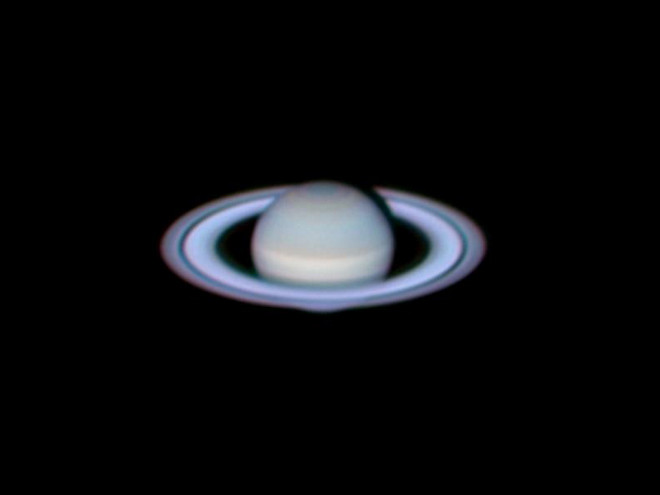
 Orion is proud to partner with BBC Sky at Night Magazine, the UK's biggest selling astronomy periodical, to bring you this article as part of an ongoing series to provide valuable content to our customers. Check back each month for exciting articles from renowned amateur astronomers, practical observing tutorials, and much more!
Orion is proud to partner with BBC Sky at Night Magazine, the UK's biggest selling astronomy periodical, to bring you this article as part of an ongoing series to provide valuable content to our customers. Check back each month for exciting articles from renowned amateur astronomers, practical observing tutorials, and much more!
Titanic Discoveries at Saturn
Long regarded as the 'wow' planet of the Solar System, Saturn proved more magnificent than anyone had imagined. While it was in the neighbourhood, Voyager 1 skimmed past Titan, still the only moon we know of with a thick atmosphere.

Photograph by Cherdphong Visarathanonth in Prawet district, Bangkok, Thailand
On the evening of 6 November 1980, less than a week before reaching Saturn, Voyager 1 fell abruptly, though not unexpectedly, silent. Bruce Murray, then serving as director of the Jet Propulsion Laboratory (JPL) in Pasadena, California, was not alone in having expressed consternation over the hazardous manoeuvre that was about to take place. After all, the tiny spacecraft was three years into an epic mission of exploration that had already rewritten the textbooks on Jupiter. Now, more than 1.4 billion km from Earth, it was having its critical communications link with Earth intentionally severed so the craft could be turned towards Titan.
"Isn't it risky," Murray asked at one of the last pre-Saturn meetings, "to break communications, so close to encounter?" It was indeed a dauntingly bold move, but there was a clear rationale for it. Voyager 1 was following a route known as 'Jupiter-Saturn-Titan' so it could observe, at close quarters, the only natural satellite in the Solar System definitively known to possess a dense atmosphere.
If it was to fly within 3,900km of Titan's soup-like canopy of gases and particulate haze, a trajectory-correcting firing of the spacecraft's thrusters was needed. And to accomplish that, Voyager 1 had to reposition itself a quarter-turn away from its lock on Earth.
The Deep Space Network's tracking station in Goldstone, California, duly transmitted the requisite commands up to the spacecraft. It took 84 minutes, travelling at the speed of light, for those commands to cross the immense gulf between Earth and the Saturnian system.
Voyager 1 responded crisply, rotating its high-gain antenna away from Earth. Its hydrazine-fuelled thrusters hissed for almost 12 minutes, affording it a slight sideways nudge for the Titan flyby. The probe then realigned itself with our world. To everyone's immense relief, communications were restored 84 minutes later.
Investigations Begin
The first dividend was paid soon after. Early on 11 November, the spacecraft's radio signal passed through Titan's thick orange clouds, gradually faded and then vanished, reappearing after 13 minutes. The signal's 'occultation' allowed investigators to show that Titan's atmosphere — first detected spectroscopically in the 1940s — was far more substantial than anticipated. Later analysis of the signal data revealed the existence of a solid surface with a temperature of –180°C.
The radio signal also showed the moon to have an equatorial diameter of around 5,150km. This was a significant find as, until 1980, the unknown size of Titan's opaque veil had spawned the erroneous assumption that it was the biggest natural satellite in the Solar System, larger even than Jupiter's moon Ganymede. An occultation of our Moon, seen from Earth a few years earlier, suggested an optical size of 5,800km, but this figure was biased by a lack of precise detail regarding the thickness of Titan's clouds. With Voyager 1's data, it was possible to ascertain that Ganymede is marginally the larger of the two, and that both moons are bigger than the Solar System's innermost planet, Mercury.
Titan's equatorial tilt causes distinct seasons and Voyager 1 was able to show that gases and particulates migrate from one hemisphere to the other. Along with the sheer density of the atmosphere, this highlighted broad differences in albedo. Neither Voyager 1 nor Voyager 2, which swept 907,000km past Titan in August 1981, saw any trace of a solid surface through the murk, but they did identify a dark brown 'hood' of detached haze over the north pole. This contrasted starkly with the far brighter south and provided a glimpse of the seasonal variation — at the time it was spring in the north and autumn in the south.
The moon's atmosphere was known to contain methane long before the Voyager probes arrived, although it turns out that methane only accounts for a few per cent. In fact, protons from Saturn's fierce magnetosphere and ultraviolet photons from the solar wind separate molecules of nitrogen and methane. Their atoms recombine into a raft of trace constituents, including hydrogen cyanide and acetylene, many of which were detectable to the Voyagers' infrared instruments. Hydrogen cyanide plays an important role in the synthesis of amino acids and its discovery at Titan triggered early theories that the moon might harbour the building blocks for complex organic chemistry. Indeed, it may even mirror conditions on the infant Earth, as it was billions of years before life evolved here.
A Complicated Picture
During their rapid transits, the Voyagers observed cooler temperatures nearer the moon's and warmer ones in the high troposphere, a phenomenon known as 'temperature inversion'. It's driven primarily by ultraviolet sunlight and contributes to Titan's already complicated photochemical picture, which is dominated by a dense layer of hydrocarbon 'smog', 200km thick, whose particulates vary in size from 0.2Ám to 1Ám. Even in 1980, it was argued that these particulates could 'snow' onto Titan's surface, and so the existence of hydrocarbon lakes and seas was plausibly considered for the first time.
Eighteen hours after leaving Titan, Voyager 1 hurtled 64,200km past the sickly yellow cloud-tops of Saturn, the Solar System's most visually spectacular planet. Its intricate rings, which so puzzled Galileo in 1610, before they were correctly described and identified by Christiaan Huygens in 1655, have a radial breadth of 282,000km, equivalent to three-quarters of the distance but are believed to be no more than 1.4km thick.
Three rings, dubbed A, B and C, together with the 4,800km-wide Cassini Division, were known to astronomers long before the dawn of the Space Age. In September 1979, Pioneer 11 found the F ring, which resembled a contorted tangle of narrow strands. Moreover, its data hinted strongly at the possible existence of tiny 'moonlets', which somehow anchored, or 'shepherded', the ring material along its million-kilometre-long tracks. A year later, Voyager 1 discovered the moonlets Prometheus and Pandora, both of which straddled and possibly influenced the structure of the F ring. Unfortunately, a defective photopolarimeter meant that the probe was unable to examine them in great detail.
Still, Voyager 1 managed to locate the dusty D ring and the exceptionally slender G ring. Nine months later, Voyager 2 encountered Saturn with a fully functioning photopolarimeter and managed to resolve groups of hitherto-unseen 'ringlets', showing that very few gaps existed anywhere in the rings.
Even the notionally 'empty' Cassini Division, the broad, dark band of which separates the bright A and B rings, turned out to be populated by a vast mass of dust and rocky fragments. Radio-science measurements confirmed that the most closely spaced particles ranged in size from under 1cm to 10m or more.
The Rings' Origins
The principal constituent of the rings is water-ice. It makes up 99.9 per cent of the rings and is what makes them so dazzlingly reflective, although both Voyagers saw discoloration in places, perhaps due to the presence of impurities such as tholins or silicates. Until 1980, scientific consensus favoured gravitational forces as the driving force behind the rings' formation. Yet the Voyager probes uncovered radial features, including spokes and kinks that are inconsistent with gravitational orbital mechanics.
Voyager 1 took a sequence of images during one of Saturn's rotations that revealed the spokes' formation and dissipation lifecycles. The images showed them to be charged particles that levitated above the rings.
It had been argued that divisions within the rings were formed by the process of orbital 'resonance', whereby particles were confined to specific regions by the gravitational attraction of neighbouring shepherd moons. The discovery of Prometheus and Pandora lent credence to this idea, and particles bordering the Cassini Division are thought to be influenced by the presence of the moon Mimas.
Elsewhere, particles near the edge of the A ring are 'sharpened' by the moonlet Atlas — its astonishing equatorial ridge might represent a deposit of swept-up ring material — and by the co-orbiting moonlets Epimetheus and Janus.
Another moonlet, the walnut-shaped Pan, was found in 1990, following an analysis of old Voyager 2 images. It's thought to be responsible for 'scalloping' the edges of the 325km-wide Encke Gap in the A ring and keeping it free of particles. Still other openings in the rings — including the Cassini Division and the narrower Huygens Gap — are thought to be controlled in part by the influence of Mimas. Another gap, measuring 42km in diameter and named in honour of astronomer James Keeler, was detected by the Voyagers deep within the A ring.
Giant Storms
Unexpectedly, the composition of Saturn's atmosphere was quite distinct from Jupiter, with smaller helium abundances and a larger relative share of hydrogen — about 96 per cent, compared to the Jovian 87 per cent. Like its larger cousin, Saturn was shown to radiate more heat into space than it absorbed from incident sunlight and it rotates rapidly upon its axis, generating the polar flattening and outwardly bulging equator that's a curious characteristic of all four giants.
In a further contrast to Jupiter, Saturn is 30 per cent less massive, leading to the famous idiom that if a sufficiently large bathtub could be found, it might float on the water. Its latitudinal banding is also much less obvious. But the world whose name pays homage to the fabled father of Jupiter and Bringer of Old Age is by no means an inactive place. Half a century before the Voyagers visits, comedian and amateur astronomer Will Hay observed an elliptical white spot near Saturn's equator, one of several periodic sightings of large-scale storms at work.
When Voyager 2 flew past the planet on 25 August 1981, it revealed eastward-gusting jet-streams, which peaked at 1,800km/h — five times faster than those on Earth. Marginally greater winds were also clocked at higher latitudes. Data from both spacecraft uncovered powerful polar aurorae at latitudes above 65°N, together with ultraviolet emissions of hydrogen at mid-latitudes.
A Parting Gift
It was Pioneer 11 that first detected the unusual alignment of Saturn's magnetic field, which is tilted by less than 1° with respect to its rotational poles, while the Voyagers observed a strange 'torus' of positively charged hydrogen and oxygen ions about 400,000km above the cloud tops. The strong emissions associated with this torus were measured by the fields-and-particles instruments, revealed a million-kilometre-wide 'sheet' of plasma, perhaps supplied by atmospheric material from Saturn and Titan. The planet's magnetosphere is much smaller than the enormous cavity that encapsulates Jupiter, but was still shown to span over two million km by Voyager 1. Nine months later, when Voyager 2 arrived, solar wind pressures had heightened and markedly compressed the sunward boundary. Then, as the spacecraft departed Saturn on the outward leg of its journey, its instruments detected a sudden drop in solar wind pressure and the magnetosphere rapidly ballooned outwards in less than six hours.
It was a final parting gift. Then Voyager 2's instruments were deactivated and the spacecraft entered hibernation for its lonely, five-year trek to Uranus; the timing had almost been poetic. It seemed as if Saturn was bidding its visitors farewell, by offering up one more mystery to perplex and astound us.
Why Does Saturn Have Such Grand Rings?
For over three centuries, from the earliest observations by Galileo Galilei and Christiaan Huygens, Saturn was believed to be the only planet to have rings. More recently, its three giant cousins have revealed their own assemblages of dust and rocky grains. Despite being far less grandiose than those of Saturn, the creation and endurance of ring systems was a mystery it was hoped the Voyagers could help solve.
Two main theories took centre-stage before 1980. The first, by Edouard Roche, postulated that small moons residing at specific distances from a given planet would be torn apart by tidal forces and the debris might settle into rings. The second, by Pierre Laplace and Immanuel Kant, argued that the rings formed at the same time as Saturn, in a process similar to how the Solar System formed from a large disc.
As viewed by the Voyager probes, discrete particles in the rings were so bright and pristine — formed almost wholly water-ice, with some trace contaminants — that they seemed no older than a few hundred million years. Some particles are so small (from car-sized boulders to sand-like grains) that they would have been pulled into the atmosphere if they were much older than this. Furthermore, the Voyagers revealed exceptionally low levels of ambient radiation at Saturn, implying that the rings have thrived in a relatively benign environment.
This contributed to early theories that Jupiter, Uranus and Neptune lost their primordial gaseous discs quite early in their evolution, leaving mainly volatiles from which to assemble their far darker and less expansive ring systems. Saturn, on the other hand, cooled sufficiently early for water vapour to condense and eventually produce far more brilliant rings. During their encounters, the Voyagers also uncovered much more intricate detail, from spokes and kinks to ringlets and shepherd moons, than had been expected.
A Growing Moon Menagerie
Around a dozen moons were known to orbit Saturn before the Voyagers visited, the largest among them being the planet-sized Titan. Next largest was rocky Rhea, one-third the size at 1,530km in diameter.
It was Rhea — stripped of a 'sensible' atmosphere, globally crater-scarred and seen only from a great distance by both Voyager craft — that had endured two savage epochs of meteoroid bombardment in its youth. Those epochs are thought to have generated many craters on Saturn's other moons. Most intriguing are Tethys and Mimas, both predominantly water-ice, which showcase the biggest craters in proportion to their size ever seen. In fact, Mimas's Herschel crater (almost 10km deep and 130km across) covers a third of its diameter, so enormous that its causative impact must have almost broken the moon apart. Tethys boasts a shallower, more ancient feature, called Odysseus, which also spans a wide fraction of its terrain.
Then there's enigmatic Iapetus, which a bewildered Giovanni Cassini identified as 'two-toned' — bright on one face, dark on the other. The Voyagers revealed a meandering, 300km-wide transitional zone between the two halves, suggesting that preferential bombardment of Iapetus's leading hemisphere by darkened material could be responsible. Elsewhere, icy Enceladus reflects virtually all incident sunlight, rendering it the brightest-known natural satellite and raising early suspicions of 'cryovolcanism'. Rugged Dione was shown to possess a co-orbital companion moon, while potato-shaped Hyperion might be the remnant of an ancient collision and blob-like Phoebe could represent a seized asteroid.
With the Voyagers' close-range observations of Janus and Epimetheus, the floodgates opened. Three more moons (Atlas, Prometheus and Pandora) were found by the Voyagers and later Earth-based work on their imagery led to the detection of others, including Pan. Today, it's known that more than five dozen moons with confirmed orbits exist at Saturn, but the presence of innumerable particles within the rings — from grains to moonlets — could carry this figure into the thousands or beyond.
Copyright © Immediate Media. All rights reserved. No part of this article may be reproduced or transmitted in any form or by any means, electronic or mechanical without permission from the publisher.






 /
/ 







